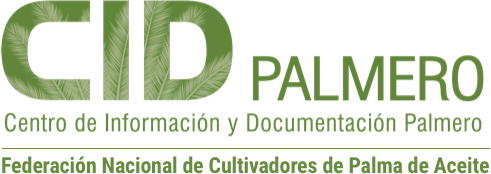| dc.creator | Alfonso Carvajal, Oscar Alberto | |
| dc.creator | Botero Serna, Juan Pablo | |
| dc.creator | Moreno Cárdenas, Edilson León | |
| dc.date | 2013-12-04 | |
| dc.date.accessioned | 2020-07-25T11:20:42Z | |
| dc.date.available | 2020-07-25T11:20:42Z | |
| dc.identifier | https://publicaciones.fedepalma.org/index.php/palmas/article/view/10807 | |
| dc.identifier.uri | http://repositorio.fedepalma.org/handle/123456789/140368 | |
| dc.description | La cantidad de frutos sueltos desprendidos que caen al suelo después del corte de los racimos de la palma de aceite Elaeis guineensis, Jacq. depende de varios factores: ciclos de cosecha, manejo de los platos, herramientas usadas para recoger el fruto, experiencia del operario y edad de la palma. Todos estos elementos afectan la eficiencia, calidad y tasa de extracción de aceite. El objetivo de este trabajo fue evaluar la eficiencia de la recolección de fruto suelto de varios sistemas disponibles. La evaluación se realizó en la Plantación Guaicaramo S.A. (Barranca de Upía, Meta). Se evaluó el sistema manual que incluye la recolección asistida por rastrillo plástico en función de dos ciclos de cosecha: 10 a 12 días (ciclo corto) y 18-20 días (ciclo largo). Para recoger 1 kg de fruto suelto se emplearon 1,3 minutos en la frecuencia de 10 a 12 días (rendimiento de 0,76 kg/min); mientras que para recoger 2,7kg de fruto suelto en el ciclo de 18 a 20 días, fue de 2,6 minutos (rendimiento de 1,03 kg/min). La cantidad de fruto suelto por tonelada de racimos de fruta fresca (RFF) varió entre 45 y 142 kg/t de racimos. Al aumentar el ciclo de cosecha en el tratamiento manual con rastrillo, el contenido de materia extraña fue mayor, pasando de 26% en el ciclo corto a 30% en el ciclo largo. El análisis económico mostró que al aumentar el contenido de impurezas en fruto de 26 a 30%, se incrementa el pago de $69.388 a $175.176 ha/año. El rendimiento de la labor de recolección no varió en función del sistema empleado ni del ciclo de cosecha. Sin embargo, en el ciclo largo aumenta el contenido de impurezas que se pagan como si fueran frutos de calidad óptima. | es-ES |
| dc.description | The collection of loose fruit from oil palm bunches Elaeis Guineensis, Jacq. depends on several factors such as: weed management around of the palm stem, harvest cycles duration, tools used, ability of the labor and age of the palm. Each of the previous factors could affect the picking efficiency, quality and quantity of the loose fruit recollected and the final oil extraction rate (OER). The purpose of the present work was to evaluate the amount of loose fruit left behind on the floor after the harvest, the quality of the fruits and picking efficiency of the hand labors. The evaluation was conducted at the Guaicaramo S.A. plantation (Barranca de Upía, Meta). Two systems were used to collect the fruit from the soil surface (manual picking and manual picking using a plastic rake as a gathering tool as a function of two harvesting cycles (10 to 12 days and 18 to 20 days). The amount of loose fruit picked in the normal cycle was 0.76 kg/min while the long cycle resulted in a picking efficiency of 1.03 kg/min. The loose fruit per ton of FFB showed in proportion of the duration of the harvesting cycle, being of 45 kg for a normal cycle and 142 kg for a long cycle. The amount of extraneous matter increased with the length of the harvesting cycle, increasing 26% to 30% with longer cycle. The economic analysis depicted that the cost associated with the level of fruit impurities, increased from $69,388 ha/year for 26% content of extraneous matter to $175,176 ha/year for 30% level of extraneous matter. The picking efficiency did not change as a function of picking system or the cycle length. However, the amount of impurities increased for the long cycle. This situation is no attractive while the extraneous matter content is being paid as fruit that steal oil from the extraction process. | en-US |
| dc.format | application/pdf | |
| dc.language | spa | |
| dc.publisher | Fedepalma | es-ES |
| dc.relation | https://publicaciones.fedepalma.org/index.php/palmas/article/view/10807/10799 | |
| dc.rights | Derechos de autor 2017 Revista Palmas | es-ES |
| dc.rights | https://creativecommons.org/licenses/by-nc-nd/4.0 | es-ES |
| dc.source | Revista Palmas; Vol. 34 Núm. 1 (2013); 9-18 | es-ES |
| dc.source | 0121-2923 | |
| dc.subject | harvest cycle | en-US |
| dc.subject | picking systems | en-US |
| dc.subject | yield | en-US |
| dc.subject | extraneous matter | en-US |
| dc.subject | ciclo de cosecha | es-ES |
| dc.subject | sistemas de recolección | es-ES |
| dc.subject | rendimiento | es-ES |
| dc.subject | impurezas en fruto suelto | es-ES |
| dc.title | Recolección del fruto suelto de palma de aceite (Elaeis guineensis, Jacq.) | es-ES |
| dc.title | Loose Oil Palm Fruit (Elaeis Guineensis, Jacq.) Collection | en-US |
| dc.type | info:eu-repo/semantics/article | |
| dc.type | info:eu-repo/semantics/publishedVersion | |


